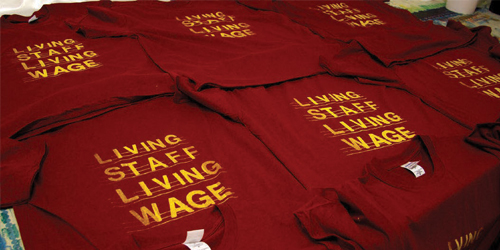
 Announced to raucous cheers from his Tory colleagues in the budget in July 2015, the introduction of the National Living Wage (“NLW”) was Chancellor George Osborne’s headline-grabber. The business community was stunned. Greg Burgess of DMH Stallard’s Employment Law Group explains exactly what it is, and looks at how it is likely to affect businesses in the South East.
Announced to raucous cheers from his Tory colleagues in the budget in July 2015, the introduction of the National Living Wage (“NLW”) was Chancellor George Osborne’s headline-grabber. The business community was stunned. Greg Burgess of DMH Stallard’s Employment Law Group explains exactly what it is, and looks at how it is likely to affect businesses in the South East.
Q: So what is the NLW?
Rather than being something entirely new, it is in fact just a higher, National Minimum Wage level for workers aged 25 and over. It does not affect workers aged under 25, who will remain entitled to the National Minimum Wage (of £6.70 for 21-24 year olds, and £5.30 for 18-21 year olds). It came into force on 1 April 2016.
Q: Doesn't the NLW already exist?
Yes, the concept does exist, but until now it has been an entirely voluntary thing. Over the last few years, employers have been able to sign up to be accredited Living Wage Employers. This accreditation is provided by the Living Wage Foundation.
Over 2,000 employers across the country have signed up to pay the optional living wage of £9.40 in London and £8.25 outside of London.
Q: Why is it now being forced upon employers?
As the cost of living rises faster than average wage growth, low earners will inevitably suffer the most. It is estimated that the NLW will affect 4.5 million low paid workers initially. As the NLW increases it is estimated that by 2020 it will affect 6 million low paid workers.
Q: What are the pay rates?
From April 2016 the NLW will be £7.20 per hour for workers aged 25 and over. The aim is for it to ultimately rise to £9 per hour by 2020. It will rise each year until 2020, although it is not yet known by how much.
Q: What is it going to cost British business?
As usual, various figures have been published about the financial impact on British business. The Federation of Small Businesses says around 40% of its members will be directly affected by the NLW. The greatest impact is likely to be in those sectors which already operate on tight margins, such as hospitality, care and retail. Interserve, who employ 15,000 cleaners, estimate that the cost to them will be £15m a year, equivalent to 12% of its annual profits. Care provider Mears Group estimates an extra £5m on its wage bill for its 4,000 care workers.
Q: What are the options for companies who are now faced with an increase in their wage bill?
This very much depends on factors specific to the business or industry they are operating in. A recent survey of companies showed a variety of ways they were proposing to fund it:
- 40% of companies said they would absorb the cost;
- 25% suggested they would pass the cost on to their customers;
- 21% said they would introduce a pay freeze;
- 14% said they would reduce bonuses and discretionary payment;
- 11% said that they would reduce benefits packages.
The challenge for businesses is that the sectors that are most likely to be affected by the introduction of NLW are those that already operate on relatively tight margins. Those that operate for example in the retail sector, or supply into the retail sector, are unlikely to be able to pass on the additional cost to their customers.
Q: What are businesses in Sussex and Surrey doing to respond to the introduction of the NLW?
Fortunately, average wage rates in London and the South East are relatively high, although that is in part because the cost of living is higher than in other parts of the country. However, it would be wrong to think that businesses locally are not affected.
There appears to be a wide variety of different approaches from businesses across the region. We have spoken to businesses, for example, in the hospitality sector who are hit with additional costs of several hundred thousand pounds, in an environment where price competition on room rates is so fierce. Unable therefore to pass additional cost on to their guests, they are having to review all of their variable costs and specifically employee benefits packages in an attempt to protect their margin. However, seeking to change employees’ terms and conditions especially where it results in financial loss to staff is inherently risky, and requires careful planning. The knock-on effect of increasing wage rates for the lowest paid staff, is that it is forcing businesses to also review and potentially increase the wage rates for the next level of staff, to ensure the gap in pay bands between staff at different levels are preserved. For those businesses that it does impact, the impact is potentially more dramatic than might first be thought.
In Sussex, since 2012, Brighton and Hove Chamber of Commerce have spearheaded a campaign to encourage local businesses to pay the Living Wage. The Brighton and Hove Living Wage Campaign is the only business-led campaign in the UK. It aims to make Brighton and Hove a great example of how the Living Wage can become the normal and accepted minimum level of payment for employers in the City.
Over 260 businesses have signed up to show their commitment and are continuing to do so, even after the announcement of the government’s ‘National Living Wage’.
Sarah Springford, Director of the Brighton and Hove Chamber of Commerce comments, “Whilst paying the Living Wage has clear benefits to employees, we’ve found that there are benefits for businesses too. In our recent survey, businesses told us that they’ve won tenders because they are a Living Wage employer and it’s been great PR for their business. Others said that staff morale has improved, as well as their reputation in the City as an ethical employer.”
Businesses can sign up to the Brighton & Hove campaign (at no cost) at:
www.livingwagebrighton.co.uk
If your business needs help finding solutions to help manage the impact of the NLW then please contact Greg Burgess in the Employment Team at DMH Stallard at greg.burgess@dmhstallard.com.






